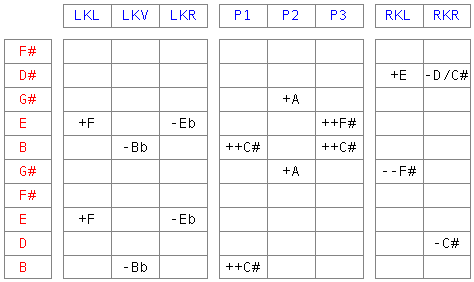In the mid 1950’s, Buddy Emmons contributed to the evolution of the pedal steel guitar by splitting the function of the two pedals that changed the pitch of several strings from the I chord to IV chord. This “split-pedal” setup became the standard pedal arrangement in the E9 tuning, since it allows greater musical flexibility than the earlier pedal setup pioneered by Bud Isaacs. Buddy also expanded the tuning from 8 to 10 strings, adding the first two so-called “chromatic” strings.
His copedent evolved over the years, including experiments with 12-string necks tuned to E13th. Most sources agree with the basic arrangement in the chart shown below for his D-10 instruments. It’s very typical of how most new guitars are configured today, except for the lack of a 1st string raise on RKL.

See also: Buddy Emmons’ C6th Copedent
Are pedal steels tuned equal tempered, or in barbershop intervals?
Buddy claimed that he used equal temperament, but it’s clear on his early E9th recordings that he flatted his thirds. He probably used equal temperament on his C6th neck and tweaked it a bit for a sweeter sound in country ballads on E9th. Most steel players use something close to just intonation (barbershop intervals). See my page about it at http://www.b0b.com/infoedu/just_e9.html
In your chart you have for example +F, – Bb, and ++c#
what do the + or – stand for, some charts show eg.
F+1 or F-1 I’m just a beginner and love the steel guitar
sound and am anxious to learn thanks.
In my copedent charts, + means raise 1/2 step, ++ means raise a full step, – means lower a half step, etc.
When you say flat 3rd, I assume
it’s the g sharp flat 2 cents on korg
tuner.
Yes, and also the pedaled C# (major 3rd of A), the Eb lever (major 3rd of B), and the F lever (major 3rd of C#). The actual amount in cents varies from player to player, and sometimes from one guitar to another depending on the amount of cabinet drop. The F lever gets twice the amount, because it is the major 3rd of the C# which has also been lowered.
I’m just curious what LKV stands for and what it might do. Sorry for the possibility simple question.
Left Knee Vertical – it’s a knee lever that you push upwards instead of sidways.
Ok. Thanks!! I have a pedal steel that only has 4 knee levers (lkl, lkr, rkr, rkl, you get it). Is the lkv the type of thing that can be installed? Again, sorry for the potentially silly question
I suppose it depends on the brand. Contact the manufacturer. If they’re no longer in business, ask in the Pedal Steel section of The Steel Guitar Forum.
But honestly, the vertical knee lever isn’t necessary. A lot of guitars don’t have it, and many people who have it don’t use it anyway.
So to use the LKV-lever, I guess you have to raise your heel from the floor. But how can you then use the pedals, if your heel is in the air? Seems physically impossible…
I often use the LKV with a pedal down, pusing up with my ankle from my toe. It’s not easy to push LKV with your foot suspended in the air so, if I’m not using a pedal, I put my toe on the floor to help with the upward push.
I’m confused by the RKR. The -D/C#. How does this work? Does one simply tune it for a full versus half step decrease? Thanks in advance.
There is a soft stop at the D note which you can feel. Pushing further lowers the string to C#. Typically, the stop is the point at which the 9th string lower engages.
Wow Bob Lee – I am sooooo impressed with your explanations – I’m just beginning to look at giving this fascinating instrument a try, and you are a big help 🙂
Bob your very good at explaining the Steel Guitar. I can see that you have good knowledge about this Instrument that makes Beautiful music. I enjoy reading your answers to the questions…Your very smart about the Steel Guitar…And I know that you love to play your Guitar. I love to play my Steel Guitar…But Lower Back problems prevents me from picking my guitar…But I am working on that problem. Keep up the good work Bob…Its good to know that there is someone that is willing to help folks that need it,
Bob your A good man.
Bill Sutton.
Thanks Bob, you’ve enriched my life more than you could ever know. This forum of knowledge continues to be the pinnacle of steel guitar knowledge to provide for the continuation of steel guitar with and without pedals.
bOb Lee – thanks for everything.
Rest in peace, Drew.